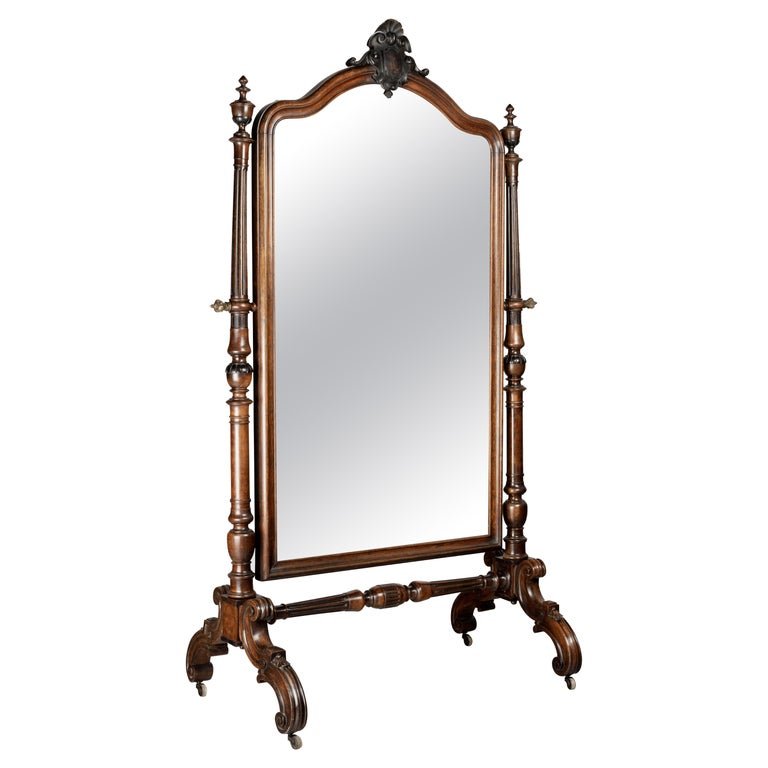Antique mirrors are special. They are not just normal mirrors. They have a history. They tell stories. They can change the look of a room. But, what are they made of? Let’s explore the materials used in antique mirrors.
1. The Glass
The most important part of a mirror is glass. Antique mirrors use different types of glass. Here are some common types:
- Blown Glass: This glass is made by blowing air into a molten glass blob. It creates beautiful shapes. This method was used a long time ago.
- Cast Glass: In this method, glass is poured into molds. This makes flat sheets. Cast glass was popular in the 17th century.
- Plate Glass: This is made by polishing glass. It creates a smooth and clear surface. Plate glass became common in the 19th century.
Each type of glass gives the mirror a different look. Antique mirrors often have a unique charm. They may not be perfectly smooth. This adds to their beauty.

Credit: www.thehoarde.com
2. The Backing
Next, we need to talk about the backing of the mirror. The backing is what holds the glass. It also gives the mirror its shape. Antique mirrors use several materials for backing:
- Wood: Many antique mirrors have wooden backs. Wood is strong and sturdy. It can also be carved into beautiful designs.
- Metal: Some mirrors use metal for backing. This makes the mirror very strong. Metal can also be shaped in interesting ways.
- Cardboard: Later antique mirrors sometimes used cardboard. It is lighter but not as strong. Cardboard was used in the 19th century.
The backing material affects the mirror’s look and feel. Wooden backs can add warmth. Metal backs can bring a modern touch.
3. The Silvering
Now, let’s discuss silvering. Silvering is the process that makes a mirror reflective. This is done by applying a thin layer of silver to the glass. In the past, people used different methods:
- Mercury: Early mirrors used mercury to make them shiny. This method was popular in the 16th century. However, mercury is toxic. It is dangerous to use.
- Silver Nitrate: Later, silver nitrate became common. It is mixed with other chemicals. This creates a reflective layer. Silver nitrate is safer than mercury.
Silvering is an important step. It makes the mirror reflect light. The quality of silvering affects how clear the reflection is.
4. The Frame
The frame of an antique mirror is just as important. It holds the mirror in place. It also adds to its beauty. Antique mirror frames can be made of:
- Wood: Many antique mirrors have wooden frames. These frames can be carved or painted. They add character to the mirror.
- Metal: Some mirrors have metal frames. These can be ornate or simple. Metal frames can give a modern feel.
- Gesso: Gesso is a mixture of plaster and glue. It is often used on wooden frames. It can be painted and decorated.
The frame can tell a lot about the mirror’s age. Older frames are often more detailed. They show the craftsmanship of the time.

Credit: www.ofleury.com
5. The Age of the Materials
One thing to remember is the age of the materials. Antique mirrors are often made from older materials. This can affect their value. Older mirrors may have imperfections. These imperfections are part of their charm.
- Patina: This is a natural aging process. It creates a unique look on the surface. Patina can make a mirror more valuable.
- Wear and Tear: Some scratches or spots may be present. These show that the mirror has a history. Many people love this character.
When buying an antique mirror, check the materials. Older materials can mean higher value.
6. Caring for Antique Mirrors
Caring for antique mirrors is important. You want to keep them beautiful. Here are some tips:
- Keep them clean: Use a soft, dry cloth. Do not use strong chemicals. They can damage the mirror.
- Avoid direct sunlight: Sunlight can fade the colors. It can also damage the backing.
- Store properly: If you need to store the mirror, wrap it carefully. Use soft materials to protect it.
Proper care can help antique mirrors last. They can be enjoyed for many years.
7. Conclusion
Antique mirrors are beautiful and special. They are made from various materials. The glass, backing, silvering, and frame all matter. Each piece tells a story. Understanding these materials helps us appreciate antique mirrors more.
When choosing an antique mirror, look at the details. Check the age and condition. With proper care, these mirrors can shine for generations. Antique mirrors are more than just reflections; they are pieces of history.
Now you know what antique mirrors are made of. They are unique and full of charm. Antique mirrors can add beauty to any room. Consider adding one to your home.
Frequently Asked Questions
What Materials Are Antique Mirrors Usually Made Of?
Antique mirrors are commonly made of glass, wood, and metal. These materials provide durability and beauty.
How Can I Tell If A Mirror Is Antique?
Look for signs like aged glass, irregularities, or a wooden frame. These features often indicate an antique mirror.
Why Are Antique Mirrors So Valuable?
Their value comes from craftsmanship, age, and historical significance. Rare pieces can fetch high prices.
Do Antique Mirrors Require Special Care?
Yes, clean them gently with a soft cloth. Avoid harsh chemicals to preserve their finish.

